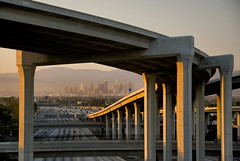Effects of the Los Angeles transit strike on highway congestion
(this paper was mentioned in an entry on The Overhead Wire)
the abstract from the paper by Shih-Che Lo and Randolph W. Hall:
In this paper we investigate the effect of the Los Angeles transit strike on highway congestion through analysis of highway sensor data, using both a before-and-after comparison, and a control group comparison. We found that average 5:00 a.m. to 10:00 p.m. traffic speeds declined by as much as 20% during the strike, and the average length of the rush period increased by as much as 200%, even though increases in traffic were small, despite the fact that transit riders constitute a small fraction of the traveling population. Speeds declined the most at locations upstream from the places where queues normally end. We believe that highways are especially susceptible to congestion during strikes because travelers have little opportunity to adjust and equilibrate their travel patterns, as is possible during ordinary periods of traffic growth.
Underline added.
This isn't a surprise. Maximum throughput on road lanes per mile caps out at about 2,200 cars/hour on highways, maybe 1,200 to 1,400 cars/hour on major arterials, and in cities, from 300 to 800 cars/hour, depending on the number of traffic signals. So yes, small changes in the amount of traffic can have significant, cascading impact.
(Flickr image of the Harbor Freeway Interchange in Southern California by g.s. george.)
Labels: car culture and automobility, transit, transportation planning




0 Comments:
Post a Comment
<< Home